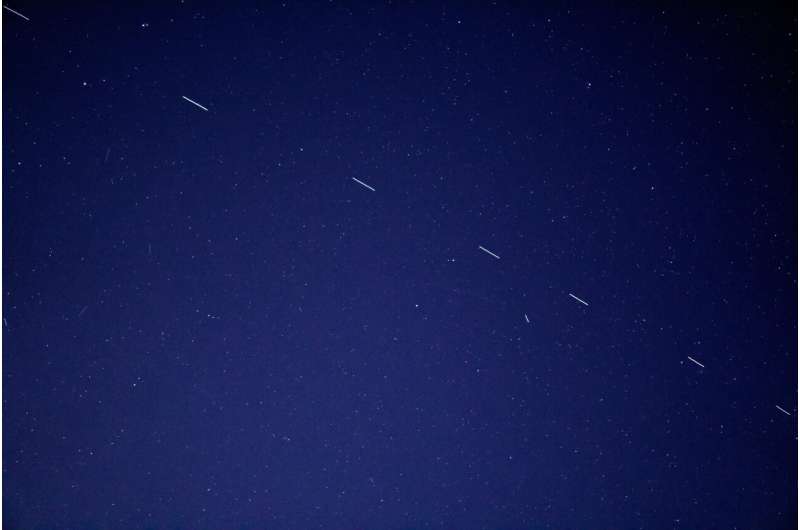Science
Breathtaking Early Stages of Star Formation Captured With James Webb Space Telescope – SciTechDaily
Researchers are getting their first glimpses inside distant spiral galaxies to see how stars formed and how they change over time, thanks to the James Webb Space Telescope’s ability to pierce the veil of dust and gas cloud. Credit: Science: NASA, ESA, CSA, Janice Lee (NOIRLab), Image Processing: Joseph DePasquale (STScI)
Webb space telescope’s mid-infrared capabilities allowed scientists to see past gas and dust clouds to observe previously obscured details in faraway galaxies.
A team of researchers has been able to see inside faraway spiral galaxies for the first time to study how they formed and how they change over time, thanks to the powerful capabilities of the James Webb Space Telescope.
“We’re studying 19 of our closest analogs to our own galaxy. In our own galaxy we can’t make a lot of these discoveries because we’re stuck inside it,” says Erik Rosolowsky, professor in the University of Alberta Department of Physics and co-author on a recent paper — published in The <span class="glossaryLink" aria-describedby="tt" data-cmtooltip="
” data-gt-translate-attributes=”["attribute":"data-cmtooltip", "format":"html"]”>Astrophysical Journal Letters — analyzing data from the James Webb telescope.
Unlike previous observation tools, the telescope’s mid-infrared instrument can penetrate dust and gas clouds to provide critical information about how stars are forming in these galaxies, and consequently, how they are evolving.
“This is light that is longer wavelength and represents cooler objects than the light we see with our eyes,” says Rosolowsky.
“The infrared light is really key to tracing the cold and distant universe.”

James Webb Space Telescope artist concept. Credit: NASA
So far, the telescope has captured data from 15 of the 19 galaxies. Rosolowsky and Hamid Hassani, a PhD student and lead author on the paper, examined the infrared light emitted from dust grains at different wavelengths to help categorize what they were seeing, such as whether an image showcased regular stars, massive star-forming complexes or background galaxies.
“At 21 micrometers [the infrared wavelength used for the images collected], if you look at a galaxy you will see all of those dust grains heated with light from the stars,” explains Hassani.
From the collected images, they were able to determine the age of the stars. They discovered they were observing young stars which “erupt[ed] onto the scene practically instantaneously, far faster than a lot of models had predicted,” says Rosolowsky.
“The age of these [stellar] populations is very young. They’re really just starting to produce new stars and they are really active in the formation of stars,” says Hassani.

Webb has two sides, divided by its sunshield: a hot side facing the Sun and Earth, and a cold side facing out into space, away from the Sun and Earth. The solar panels, communications antenna, navigation system, and electronic systems reside on the hot side facing the Sun and Earth. The mirrors and scientific instruments, which are very sensitive to infrared radiation, are housed on the cold side, where they are protected by the sunshield. Credit: STScI
The researchers also found a close relationship between the mass of stars in a region and how bright they were. “It turns out this was a brilliant way to find high-mass stars,” says Rosolowsky.
Rosolowsky terms high-mass stars “rock stars” because “they live fast, they die young and they really shape the galaxy around them.” When they’re forming, he explains, they release huge amounts of solar wind and gas bubbles, which halts star formation in that particular area while simultaneously stirring up the galaxy and sparking star formation in other areas.
“We’ve discovered this is actually really key for the long-term life of a galaxy, this kind of bubbling froth, because it keeps the galaxy from going through its fuel too quickly,” says Rosolowsky.
It’s a complex process, with each new star formation playing a larger role in how the galaxy changes over time, adds Hassani.
“If you have a star forming, that galaxy is still active. You have a lot of dust and gas and all of these emissions from the galaxy that trigger the next generation of the next massive star forming and just keep the galaxy alive.”
The more images scientists have that document these processes, the better they are able to infer what is going on in distant galaxies that have similarities to our own. Rather than looking at just one galaxy in depth, Rosolowsky and Hassani want to create what Rosolowsky calls a “galaxy atlas” of sorts by capturing images using as many methods as possible.
“Through the collection of all this data, in creating this great atlas, we’d be able to sort out what’s special about one galaxy versus the unifying themes that shape galaxies as a whole,” says Rosolowsky.
Reference: “PHANGS–JWST First Results: The 21 µm Compact Source Population” by Hamid Hassani, Erik Rosolowsky, Adam K. Leroy, Médéric Boquien, Janice C. Lee, Ashley T. Barnes, Francesco Belfiore, F. Bigiel, Yixian Cao, Mélanie Chevance, Daniel A. Dale, Oleg V. Egorov, Eric Emsellem, Christopher M. Faesi, Kathryn Grasha, Jaeyeon Kim, Ralf S. Klessen, Kathryn Kreckel, J. M. Diederik Kruijssen, Kirsten L. Larson, Sharon E. Meidt, Karin M. Sandstrom, Eva Schinnerer, David A. Thilker, Elizabeth J. Watkins, Bradley C. Whitmore and Thomas G. Williams, 16 February 2023, The Astrophysical Journal Letters.
DOI: 10.3847/2041-8213/aca8ab
Their paper was one of 21 research papers on the initial findings from the Physics at High Angular resolution in Nearby Galaxies (PHANGS) collaboration, published in a special focus issue of The Astrophysical Journal Letters.
Science
SpaceX launch marks 300th successful booster landing – Phys.org


SpaceX sent up the 30th launch from the Space Coast for the year on the evening of April 23, a mission that also featured the company’s 300th successful booster recovery.
A Falcon 9 rocket carrying 23 of SpaceX’s Starlink internet satellites blasted off at 6:17 p.m. Eastern time from Cape Canaveral Space Force Station’s Space Launch Complex 40.
The first-stage booster set a milestone of the 300th time a Falcon 9 or Falcon Heavy booster made a successful recovery landing, and the 270th time SpaceX has reflown a booster.
This particular booster made its ninth trip to space, a resume that includes one human spaceflight, Crew-6. It made its latest recovery landing downrange on the droneship Just Read the Instructions in the Atlantic Ocean.
The company’s first successful booster recovery came in December 2015, and it has not had a failed booster landing since February 2021.
The current record holder for flights flew 11 days ago making its 20th trip off the launch pad.
SpaceX has been responsible for all but two of the launches this year from either Kennedy Space Center or Cape Canaveral with United Launch Alliance having launched the other two.
SpaceX could knock out more launches before the end of the month, putting the Space Coast on pace to hit more than 90 by the end of the year, but the rate of launches by SpaceX is also set to pick up for the remainder of the year with some turnaround times at the Cape’s SLC-40 coming in less than three days.
That could amp up frequency so the Space Coast could surpass 100 launches before the end of the year, with the majority coming from SpaceX. It hosted 72 launches in 2023.
More launches from ULA are on tap as well, though, including the May 6 launch atop an Atlas V rocket of the Boeing CST-100 Starliner with a pair of NASA astronauts to the International Space Station.
ULA is also preparing for the second launch ever of its new Vulcan Centaur rocket, which recently received its second Blue Origin BE-4 engine and is just waiting on the payload, Sierra Space’s Dream Chaser spacecraft, to make its way to the Space Coast.
Blue Origin has its own rocket it wants to launch this year as well, with New Glenn making its debut as early as September, according to SLD 45’s range manifest.
2024 Orlando Sentinel. Distributed by Tribune Content Agency, LLC.
Citation:
SpaceX launch marks 300th successful booster landing (2024, April 24)
retrieved 24 April 2024
from https://phys.org/news/2024-04-spacex-300th-successful-booster.html
This document is subject to copyright. Apart from any fair dealing for the purpose of private study or research, no
part may be reproduced without the written permission. The content is provided for information purposes only.
Science
Wildlife Wednesday: loons are suffering as water clarity diminishes – Canadian Geographic


The common loon, that icon of northern wilderness, is under threat from climate change due to declining water clarity. Published earlier this month in the journal Ecology, a study conducted by biologists from Chapman University and Rensselaer Polytechnic Institute in the U.S. has demonstrated the first clear evidence of an effect of climate change on this species whose distinct call is so tied to the soundscape of Canada’s lakes and wetlands.
Through the course of their research, the scientists found that July rainfall results in reduced July water clarify in loon territories in Northern Wisconsin. In turn, this makes it difficult for adult loons to find and capture their prey — mainly small fish — underwater, meaning they are unable to meet their chicks’ metabolic needs. Undernourished, the chicks face higher mortality rates. The consistent foraging techniques used by loons across their range means this impact is likely echoed wherever they are found — from Alaska to Canada to Iceland.
The researchers used Landsat imagery to find that there has been a 25-year consistent decline in water clarity, and during this period, body weights of adult loon and chicks alike have also declined. With July being the month of most rapid growth in young loons, the study also pinpointed water clarity in July as being the greatest predictor of loon body weight.
One explanation for why heavier rainfall leads to reduced water clarity is the rain might carry dissolved organic matter into lakes from adjacent streams and shoreline areas. Lawn fertilizers, pet waste and septic system leaks may also be to blame.
The researchers, led by Chapman University professor Walter Piper, hope to use these insights to further conservation efforts for this bird Piper describes as both “so beloved and so poorly understood.”
Return of the king
Science
Giant prehistoric salmon had tusk-like teeth for defence, building nests


|
|
The artwork and publicity materials showcasing a giant salmon that lived five million years ago were ready to go to promote a new exhibit, when the discovery of two fossilized skulls immediately changed what researchers knew about the fish.
Initial fossil discoveries of the 2.7-metre-long salmon in Oregon in the 1970s were incomplete and had led researchers to mistakenly suggest the fish had fang-like teeth.
It was dubbed the “sabre-toothed salmon” and became a kind of mascot for the Museum of Natural and Cultural History at the University of Oregon, says researcher Edward Davis.
But then came discovery of two skulls in 2014.
Davis, a member of the team that found the skulls, says it wasn’t until they got back to the lab that he realized the significance of the discovery that has led to the renaming of the fish in a new, peer-reviewed study.
“There were these two skulls staring at me with sideways teeth,” says Davis, an associate professor in the department of earth sciences at the university.
In that position, the tusk-like teeth could not have been used for biting, he says.
“That was definitely a surprising moment,” says Davis, who serves as director of the Condon Fossil Collection at the university’s Museum of Natural and Cultural History.
“I realized that all of the artwork and all of the publicity materials and bumper stickers and buttons and T-shirts we had just made two months prior, for the new exhibit, were all out of date,” he says with a laugh.
Davis is co-author of the new study in the journal PLOS One, which renames the giant fish the “spike-toothed salmon.”
It says the salmon used the tusk-like spikes for building nests to spawn, and as defence mechanisms against predators and other salmon.
The salmon lived about five million years ago at a time when Earth was transitioning from warmer to relatively cooler conditions, Davis says.
It’s hard to know exactly why the relatives of today’s sockeye went extinct, but Davis says the cooler conditions would have affected the productivity of the Pacific Ocean and the amount of rain feeding rivers that served as their spawning areas.
Another co-author, Brian Sidlauskas, says a fish the size of the spike-toothed salmon must have been targeted by predators such as killer whales or sharks.
“I like to think … it’s almost like a sledgehammer, these salmon swinging their head back and forth in order to fend off things that might want to feast on them,” he says.
Sidlauskas says analysis by the lead author of the paper, Kerin Claeson, found both male and female salmon had the “multi-functional” spike-tooth feature.
“That’s part of our reason for hypothesizing that this tooth is multi-functional … It could easily be for digging out nests,” he says.
“Think about how big the (nest) would have to be for an animal of this size, and then carving it out in what’s probably pretty shallow water; and so having an extra digging tool attached to your head could be really useful.”
Sidlauskas says the giant salmon help researchers understand the boundaries of what’s possible with the evolution of salmon, but they also capture the human imagination and a sense of wonder about what’s possible on Earth.
“I think it helps us value a little more what we do still have, or I hope that it does. That animal is no longer with us, but it is a product of the same biosphere that sustains us.”
This report by The Canadian Press was first published April 24, 2024.
Brenna Owen, The Canadian Press





-
News22 hours ago
Amid concerns over ‘collateral damage’ Trudeau, Freeland defend capital gains tax change
-
Art19 hours ago
The unmissable events taking place during London’s Digital Art Week
-



 Politics23 hours ago
Politics23 hours agoHow Michael Cohen and Trump went from friends to foes
-



 Real eState24 hours ago
Real eState24 hours agoBlending Function and Style: The Best Garage Door Designs for Contemporary Homes
-
News23 hours ago
U.K. tabloids abuzz with Canadian’s ‘Loch Ness monster’ photo
-



 Politics22 hours ago
Politics22 hours agoPolitics Briefing: Saskatchewan residents to get carbon rebates despite province’s opposition to pricing program
-
News21 hours ago
What is a halal mortgage? How interest-free home financing works in Canada
-
Economy19 hours ago
German Business Outlook Hits One-Year High as Economy Heals





